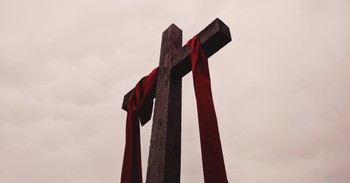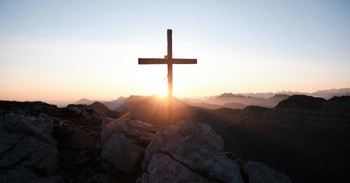
On a weekend in April 2023, a fairly rare event occurred in Jerusalem. Thousands representing three of the world’s major religions converged in a place that held special significance for them as they celebrated their holy days. For Christians, it was Easter—a time when many travel worldwide to see where Jesus was crucified, buried, and rose from the grave. For Jews, it was the time of the Passover—an annual reminder of how God saved His people from slavery in Egypt. For Muslims, it was a portion of the month of Ramadan—a time of prayer and fasting that commemorates the time of year they believe God gave the Prophet Muhammad the Qu-ran. This crossover of holidays only occurs about every 30 years.
While in Jerusalem, many visit a place of tremendous significance for all three faiths: the Western Wall, also known as the Wailing Wall. Even if you don’t know much about it, you’ve likely seen images of Orthodox Jews bowing and praying before a huge limestone wall. But why that location?
What’s the History of the Wailing Wall?
To understand the significance of the Wall, we need to go back to the beginning of the Jewish people. When God called Abraham into a covenant with Him, He tested Abraham’s faith by asking him to sacrifice his son Isaac. Of course, God provided another sacrifice, Isaac was saved—and the Jewish nation was launched through Abraham’s family line. The place where the sacrificial exchange took place was on Mount Moriah.
David wanted a temple for God built on Mount Moriah (though God called Solomon to build it). With the First Temple (also called Solomon’s Temple) in place, the location became the Temple Mount. The highlight of Solomon’s rule was that the First Temple was completed.
When the Babylonians attacked Jerusalem in 605 BC, Solomon’s Temple was destroyed, and Jews were taken captive and exiled to Babylon—men like Daniel, Shadrach, Meshach, and Abednego. Sixty-six years later, the Mede and Persian empires conquered the Babylonians, who let the Jews return. They would have been quite old by this point, but Daniel and his friends may have been among those who went back home to Jerusalem.
Dan Graves describes what happened when people returned to Jerusalem and built the Second Temple:
“In 539 BC, Babylon fell to a coalition of Medes and Persians. The new rulers of the Mid East made it their policy to restore captive nations to their respective homelands. Among those captives were the Jews. They returned to Judah with authority to rebuild their temple. Seventeen years later, construction still languished, and God raised up the prophets Haggai and Zechariah to rebuke the neglect of his house.
In 520 Haggai preached ‘Is it time for you to live in your paneled houses while this house lies in ruin?’ Through Haggai, the Lord asked the Jews how they had fared since their return. ‘You have sown much and harvested little; you eat, but you never have enough; you drink, but you never have your fill; you clothe yourselves, but no one is warm; and he who earns wages, earns wages to put them into a bag with holes’ (Haggai 1:6, Revised Standard Version). Haggai said God wanted them to bring wood and rebuild His house.
Judah’s political and religious leaders listened. Under their leadership, the remnant of exiles who had returned to Israel rebuilt God’s house, which was completed on this day, March 12, 515 BC But it wasn’t much to look at.
‘Is it not in your sight as nothing?’ the Lord asked them. Well, they should not think that way. God’s Spirit was with them. And a day was coming when the Lord would shake Heaven and earth, the sea and the dry land. ‘I will fill this house with splendor,’ God promised. ‘The latter splendor of this house shall be greater than the former,’ said the Lord. ‘From this day on, I will bless you,’ he promised.
The temple, rebuilt in 515 BC, was rebuilt yet again by Herod the Great, who restored it in stone and covered it with gold. It was that temple that Christ visited in his life, bringing it glory. A generation after Christ’s death and resurrection, Herod’s temple was cast down by the Romans. A mosque now stands on its platform.
Haggai also prophesied that all the nations would bring their treasures to the temple. That event has not been fulfilled. It awaits yet another temple when Christ returns to rule the earth from Zion.”
(“Back from Captivity, Jews Completed New Temple” by Dan Graves, MSL, first published on Christianity.com on May 3, 2010)
When Was Herod’s Temple Built?
The return to Israel did not mean the Jews became self-governing. They were conquered by one kingdom after another for hundreds of years. Fast forward to 37 BC, while Israel was under Roman rule and King Herod was made local ruler of the region of Judea.
“He is known for his colossal building projects throughout Judea, including his renovation of the Second Temple in Jerusalem,” Graves explains in an article on what became known as Herod’s Temple. The location was the Temple Mount, where Solomon’s Temple once stood, but the Western Wall was not part of Solomon’s design. When Herod was improving on the first rebuilding, he widened the temple mount plaza, including this western retaining wall.
Why Did the Romans Destroy Herod’s Temple?
In 66 AD, the Jews in Jerusalem had had enough of Roman rule, taxation, and persecution. They joined forces and successfully drove the Romans out of the city, but this superpower would not be deterred. The ESV Study Bible explains the events leading up to this great rebellion and its aftermath:
“Judean politics after Herod the Great continued in subjection to Rome. Herod’s last will was validated by Augustus, leaving Herod Antipas over Galilee and territory to the north (4 BC-AD 39), Herod Philip over northern Transjordan (4 BC-AD 34), and Archelaus over Judea (4 BC-AD 6). The Romans, judging the rule of Archelaus to be inadequate, removed him in favor of a string of Roman governors over Judea. The most famous of these governors, Pontius Pilate (who reigned AD 26-36), was much despised for his despotic acts. Favor with Rome allowed Herod’s grandson Agrippa I to rule briefly over Judea (AD 41-44), but his early death again left the governorship of Judea in the hands of Roman procurators. The Jewish historian Josephus graphically depicts the unwise and often heinous acts of this string of procurators.
Eventually anger with Rome spilled over into the Jewish revolt (AD 66-73/74). The Romans could not permit rebellion in any of their territories, let alone in an important commercial trade center such as Palestine. Thus Vespasian and his son Titus (both future emperors) were sent as generals to suppress the rebellion, which they accomplished with precision and cruelty. The destruction of Jerusalem and the Jewish temple (AD 70) transformed Jewish religion forever. Subsequently, there was a suppressed uprising of Diaspora Jews (esp. in Egypt, AD 115-117) during the reign of Trajan. Some Jews hoped for a rebuild of the Jerusalem temple, but the ineffective Second Jewish Revolt in Judea under Bar Kochba (AD 132-135, during the emperorship of Hadrian) resulted instead both in a ban on Jews entering Jerusalem and in the building of a temple to Zeus on the former Temple Mount.
Years of growing Jewish resentment toward Roman rule and paganism eventually erupted in full-scale revolt in AD 66. The revolt was ignited in Caesarea and quickly spread to Jerusalem, Judea, Idumea, parts of Samaria, and Galilee. The following spring, the Roman general Vespasian began his systematic campaign to crush the rebellion, beginning in Galilee and then moving south into Samaria and along the coast. Meanwhile, Jewish forces began to fight among themselves in a bitter power struggle between various Zealots and aristocratic leaders, thus weakening their ability to fend off the Romans as they advanced into Judea. In AD 70 the Romans captured Jerusalem and destroyed the temple, but isolated resistance still continued even as late as AD 73, when the stronghold of Masada was finally taken by the Romans.”
ESV Study Bible quotation is Taken from the ESV Study Bible copyright © (2008). Used by permission of Crossway, a publishing ministry of Good News Publishers, Wheaton, Il 60187, www.crossway.org.
The Romans destroyed the city and the temple but left a large portion of the limestone western wall standing. The location became known as the Western Wall or the Wailing Wall.
What Is the Significance of the Wailing Wall?
In a recent interview with BBC News, Rabbi Shmuel Rabinowitz, the rabbi of the Western Wall, explained its significance:
“. . . the Western Wall is the closest place to the Holy of Holies, the place in the temple where all of the prayers of all of the Jews all over the world rise up to heaven.”
If you visit the Wall, you will see people bowing in prayer, shouting prayers, and sounds of wailing and crying out to God. Rabinowitz said there is also a 300-year-old tradition of people writing prayers and stuffing them between stones in the wall.
According to Leen Ritmeyer, the world’s leading authority on the Temple Mount, the Western Wall is rarely called the Wailing Wall today. He confirmed that this location, between Wilson’s Arch and Barclay’s Gate, is the retaining wall of Herod’s Temple.
Why Is the Wailing Wall Important to Muslims and Jews?
Again, because of its proximity to the Holy of Holies of the Temple of God, Jews believe they are standing on holy ground near the Wailing Wall. On the other hand, Muslims have quite a different history with the Wall. Muslims conquered Jerusalem in 638 and built the Al-Aqsa Mosque and the beautiful, well-recognized, gold-domed Dome of the Rock. They believe this is the site where Mohammed rose to heaven at the end of his time on earth.
According to Steven Runciman in his three-volume History of the Crusades, Muslims occupied Jerusalem for 451 years, from 638 until 1099, when Muslims lost control to the Crusaders. Runciman explains that Muslims turned the tide on the Crusaders in 1187 and have had control of the Temple Mount ever since. As a result, they have had much to say about who can worship in their holiest of sites. The Jews had control of the Temple Mount for a very short time in conjunction with the Six-Day War in 1967. But for the last 50 years, as Prime Minister Benjamin Netanyahu said, “Muslims pray on the Temple Mount; non-Muslims visit the Temple Mount. So, while Jews (and some Christians) pray at the Western Wall, they are not allowed to do so.
How Does the Conflict Over the Western Wall Inspire Christians?
While a Christian who visits Jerusalem is likely looking for the holy sites related to the life of Christ (like the Church of the Holy Sepulchre–believed to be built over where Jesus was buried), they can find a reason for inspiration in the Western Wall of Herod’s Temple. Jews who pray at the Wall demonstrate that faith comes before politics. Though not legally able to pray, they do so anyway, often not quietly.
It hasn’t been called the Wailing Wall over time for no reason: Jews cry out to God often with shouts of praise and petition as they wait for the coming of the Savior. We can be even bolder in our prayer life because we know the world’s Savior has come, and He deserves all the honor and glory due to His most holy name.
Dan Graves’ Bibliography:
1. Bible. O.T. Haggai. Revised Standard Version.
2. Finegan, Jack. Handbook of Biblical Chronology. Hendrickson, 1998.
3. Tenney, Merrill C., editor. "Haggai" and "Temple." Pictorial Bible Dictionary. Nashville, Tennessee: Southwestern, 1972.
4. Wiseman, D. J. "Haggai." The New Bible Commentary Revised. Grand Rapids, Michigan: Eerdmans, 1970.
Further Reading:
How Haggai Encouraged the Rebuilding of the Second Temple
What Is the Significance of the First Temple in Jerusalem?
Do Red Heifers Mean the End Times Are Coming?
Photo Credit: Getty Images/boryak
Mary Oelerich-Meyer is a Chicago-area freelance writer and copy editor who prayed for years for a way to write about and for the Lord. She spent 20 years writing for area healthcare organizations, interviewing doctors and clinical professionals and writing more than 1,500 articles in addition to marketing collateral materials. Important work, but not what she felt called to do. She is grateful for any opportunity to share the Lord in her writing and editing, believing that life is too short to write about anything else. Previously she served as Marketing Communications Director for a large healthcare system. She holds a B.A. in International Business and Marketing from Cornell College (the original Cornell!) When not researching or writing, she loves to spend time with her writer daughter, granddaughter, rescue doggie and husband (not always in that order).


